- Books Name
- Science Made Easy Science Book
- Publication
- Science Made Easy
- Course
- CBSE Class 9
- Subject
- Science
Introduction
→ The sensation felt by our ears is called sound.
→ Sound is a form of energy which makes us hear.
→ Law of conservation of energy is also applicable to sound.
→ Sound travels in form of wave.
Production of Sound
→ Sound is produced when object vibrates or sound is produced by vibrating objects.
→ The energy required to make an object vibrate and produce sound is provided by some out
source (like our hand, wind etc.).
→ Example: Sound of our voice is produced by vibration of two vocal cords in our throat.
• Sound of a drum or tabla is produced by vibration of its membrane
when struck.
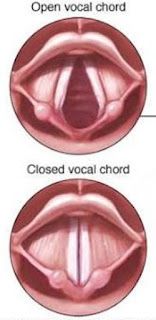
→ In laboratory experiments, sound is produced by vibrating tuning fork. The vibrations of tuning fork
can be shown by touching a small suspended pith ball (cork ball) with a prong of the sounding
tuning fork. The pith ball is pushed away with a great force.
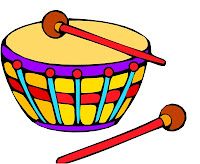
→ In laboratory experiments, sound is produced by vibrating tuning fork. The vibrations of tuning fork
can be shown by touching a small suspended pith ball (cork ball) with a prong of the sounding
tuning fork. The pith ball is pushed away with a great force.
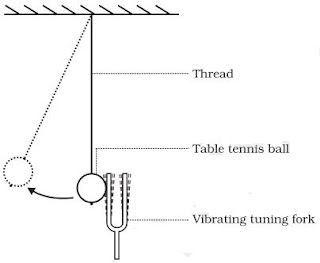
• Sound can be produced by following methods:
(i) By vibrating string (sitar)
(ii) By vibrating air (flute)
(iii) By vibrating membrane (table, drum)
(iv) By vibrating plates (bicycle bell)
(v) By friction in objects
(vi) By scratching or scrubbing the objects etc.
Propogation of Sound
→ The substance through which sound travels is called a medium.
→ The medium may be solid, liquid or gas.
→ When an object vibrates, then the air particles around it also start vibrating in exactly the same
way and displaced from their stable position.
→ These vibrating air particles exert a force on nearby air particles so they are also displaced from
their rest position and start to vibrate.
→ This process is continued in the medium till sound reaches our ears.
→ The disturbance produced by sound travels through the medium (not the particles of the
medium).
→ Wave is a disturbance which travels through a medium and carries energy.
→ So sound travels in wave form known as mechanical waves.

• When a body vibrates then it compresses the air surrounding it and form a area of high density
called compression (C).
→ Compression is the part of wave in which particles of the medium are closer to one another
forming high pressure.
→ This compression move away from the vibrating body.
• When vibrating body vibrates back a area of low pressure is formed called rarefaction (R).
→ Rarefaction is the area of wave in which particles of the medium are further apart from one
another forming a low pressure or low density area.
→ When body vibrates back and forth, a series of compression and rarefaction is formed in air
resulting in sound wave.
→ Propogation of sound wave is propogation of density change.
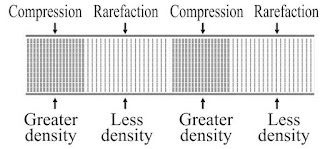
Sound needs Medium for Propogation
• Sound waves are mechanical waves.
→ It needs material medium for propogation like air, water, steel etc.
→ It cannot travel in vaccum.
→ An electric bell is suspended in airtight bell jar connected with vacuum pump.
→ So, medium is necessary for propagation of sound.
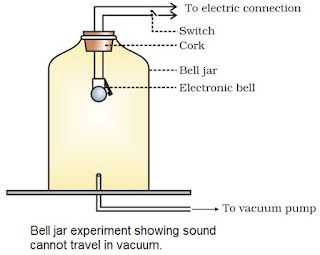
Experiment to show that sound cannot travel through vacuum
Sound Waves as Longitudinal Waves
• A wave in which the particles of the medium vibrate back and forth in the same direction in which
the wave is moving, is called a longitudinal wave.
→ When we push and pull the slinky compression (number of turns are more or closer) and
rarefaction (number of turns are less or farther) are formed.
→ When a wave travels along with slinky, its each turn moves back and forth by only a small
distance in the direction of wave. So the wave is longitudinal.
→ The direction of vibrations of the particles is parallel to the direction of wave.

• When one end of a slinky is moved up and down rapidly whose other end is fixed, it produces
transverse wave.
→ This wave possess along the slinky in horizontal direction, while turns of slinky (particles) vibrates
up and down at right angle to the direction of wave.
→ Thus in transverse wave particles of the medium vibrate up and down at right angles to the
direction of wave.
→ Light waves are transverse waves but they don’t need a material

Characteristics of Sound Wave
• The characteristics of sound waves are : wavelength, frequency, amplitude, time period and
velocity.
→ When a wave travel in air the density and pressure of air changes from their mean position.
→ Compression is shown by crest while rarefaction is shown by trough.
→ Compression is the region of maximum density or pressure.
→ Rarefaction is the region of minimum density or pressure.
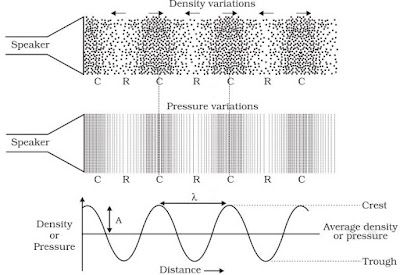
Wavelength
→ In sound waves the combined length of a compression and an adjacent rarefaction is called
wavelength.
→ The distance between the centres of two consecutive compressions or two consecutive
rarefactions is also called its wavelength.
→ It is denoted by the Greek letter lamda (λ). Its SI unit is metre.
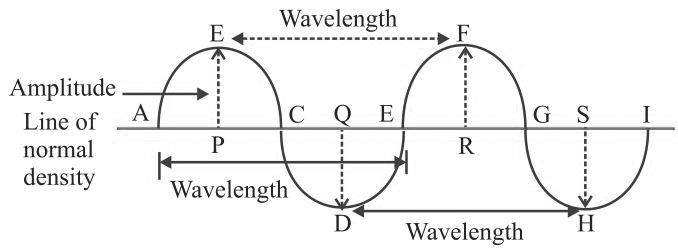
Frequency
→ No. of complete waves produced in one second or number of vibrations per second is called
frequency.
→ Number of compressions or rarefactions passed in one second is also frequency.
→ Frequency of wave is same as the frequency of the vibrating body which produces the wave
• The SI unit of frequency is hertz (Hz). The symbol of frequency is v (nu).
• 1 Hertz: One Hz is equal to 1 vibration per second.
• Bigger unit of frequency is kilohertz kHz = 1000 Hz.
Time Period
→ Time taken to complete one vibration is called time period.
→ Time required to pass two consecutive compressions or rarefactions through a point is called
time period.
• SI unit of time period is second (s). Time period is denoted by T.
• The frequency of a wave is the reciprocal of the time period.
• v = 1/T
Amplitude
→ The maximum displacement of the particle of the medium from their original undisturbed
position is called amplitude of the wave.
• Amplitude is denoted by A and its SI unit is metre (m).
→ Sound have characteristics like pitch and loudness and timbre.
• Pitch: The pitch of sound depends on the frequency of sound (vibration).
→ It is directly proportional to its frequency. Greater the frequency, higher is the pitch and lesser the
frequency, lower is the pitch.
→ A woman’s voice is shrill having a high pitch while a man’s voice is flat having low pitch.
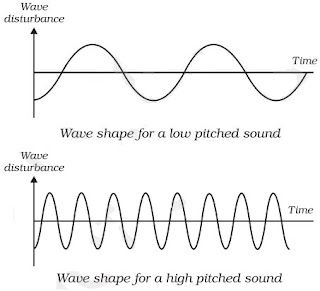
• Loudness: The loudness depends on the amplitude of the sound wave.
→ Loudness is the measure of the sound energy reaching the ear per sec.
→ Greater the amplitude of sound wave, greater is the energy, louder the sound; short is the
amplitude, less is the energy, soft is the sound.
→ Loudness is measured in decibel ‘dB’.
• Quality or Timbre: The timbre of a sound depends on the shape of sound wave produced by
the characteristic of musical sound.
→ It helps us to distinguish between two sounds of same pitch & loudness.
• Sound of single (same) frequency is called tone while a mixture of different frequencies is called
note.
• The distance travelled by a wave in one second is called velocity of the wave.
• Its SI unit is metre per second (m/s ).
Velocity = Distance travelled/Time taken
⇒ v = λ/T
(λ is the wavelength of the waves travelled in one time time period T)
v = λv (1/T = v)
So, Velocity = Wavelength × Frequency
This is the wave equation.
Example: What is the frequency of sound wave whose time period is 0.05 second ?
Speed of Sound in Various Mediums
→ Speed of sound depends on the nature of material through which it travels. It is slowest in gases,
faster in liquids and fastest in solids.
→ Speed of sound increases with the rise in temperature.
→ Speed of sound increases as humidity of air increases.
→ Speed of light is faster than speed of sound.
→ In air, speed of sound is 344 ms -1 at 22ºC.
Sonic Boom
→ Some aircrafts, bullets, rockets etc. have ‘supersonic speed’.
• Supersonic refers to the speed of an object which is greater than the speed of sound and it
produces extremely loud sound waves called ‘shock waves’ in air.

 Science Made Easy
Science Made Easy
